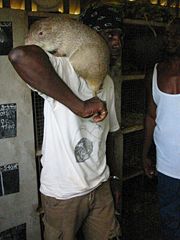Greater Cane Rat
2008/9 Schools Wikipedia Selection. Related subjects: Mammals
| Greater Cane Rat | ||||||||||||||||
|---|---|---|---|---|---|---|---|---|---|---|---|---|---|---|---|---|
 |
||||||||||||||||
| Conservation status | ||||||||||||||||
| Scientific classification | ||||||||||||||||
|
||||||||||||||||
| Binomial name | ||||||||||||||||
| Thryonomys swinderianus (Temminck, 1827) |
The Greater Cane Rat (Thryonomys swinderianus) is one of two species of cane rats, a small family of African hystricognath rodents. It inhabits Africa, south of the Saharan Desert. The cane rat lives by reedbeds and riverbanks. As humans move into such territories, the cane rats accepted plantations and cultivated areas. Cane rats can grow about two feet long in the longest individuals and weighs a little less than 19 pounds. It has rounded ears, short nose, and coarse bristly hair. Its forefeet are smaller than its hindfeet and supports its weight on only three toes. Cane rats live in small groups led by a single male. They are nocturnal and make nests from grasses or burrow underground. The oldest cane rat can live more than four years. If frightened, they grunt and run towards water. They eat grasses and cane and since they have tastes for cultivated foods, they make serious agricultural pests. So far, their conservation status is lower risk.
In the country of Ghana and other regions of West Africa, the Greater Cane Rat is usually called a grasscutter or cutting grass. In both West Africa and Southern Africa, it is considered a delicacy. As a consequence, "grasscutters" are beginning to be raised in cages for sale, and so are sometimes referred to as micro livestock.